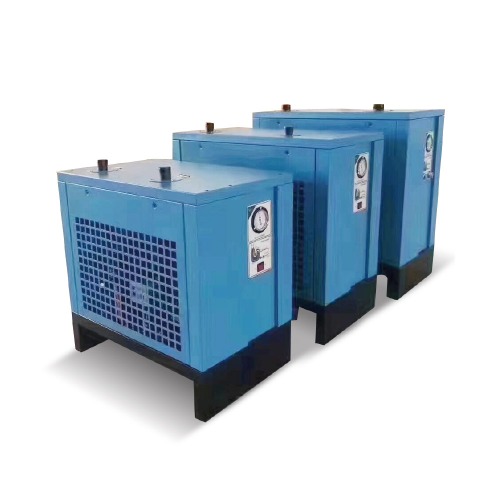News Center
The working principle of Compressed Air Dryer Machine
2023-07-18
A Compressed Air Dryer Machine, as the name suggests, is used to remove moisture and humidity from compressed air. It is an essential component in many industrial applications where dry and clean compressed air is required for efficient and reliable operation of pneumatic tools, equipment, and processes. There are different types of compressed air dryers, but the working principle of most dryers revolves around two main methods: refrigeration and adsorption.
1. Refrigeration Compressed Air Dryer:
The working principle of a refrigeration compressed air dryer is similar to that of a household refrigerator. It cools the compressed air to reduce its dew point, causing moisture to condense and separate from the air.
Here's how it works:
Compression Stage: The process starts with the compression of ambient air using an air compressor. As the air is compressed, its temperature rises, but the relative humidity decreases.
Air Cooling: The hot, compressed air is then directed through a heat exchanger, where it is cooled down using a refrigerant, typically in a closed-loop system. The refrigerant absorbs the heat from the compressed air, causing it to condense into liquid form.
Moisture Separation: The cooled air enters a moisture separator where the condensed water droplets are separated from the air stream and drained out of the system.
Reheating (Optional): In some designs, the now dry but cold air is passed through a reheater to raise its temperature before it leaves the dryer. This prevents potential issues with freezing or condensation in downstream piping.
Dry Air Delivery: The dry, clean, and moisture-free compressed air is then delivered to the point of use, ensuring optimal performance and minimizing the risk of corrosion or damage to pneumatic equipment.
2. Adsorption Compressed Air Dryer:
Adsorption compressed air dryers work on the principle of adsorbing moisture from the compressed air using a desiccant material. Commonly used desiccants include activated alumina, silica gel, and molecular sieves.
Here's how it works:
Adsorption Tower: The compressed air is directed into an adsorption tower filled with the desiccant material. As the air flows through the desiccant, it comes into contact with the porous material's surface, which has a high affinity for water molecules.
Moisture Adsorption: The desiccant material attracts and adsorbs the moisture from the compressed air, effectively removing it from the air stream.
Regeneration: Over time, the desiccant material becomes saturated with moisture and needs to be regenerated to continue its drying function. This is typically achieved by diverting a portion of the dry compressed air from the outlet back through the adsorption tower at a lower pressure or temperature. This regeneration process releases the trapped moisture from the desiccant material, allowing it to be expelled from the system.
Dry Air Delivery: Once the regeneration process is complete, the dry and clean compressed air is ready to be delivered to the point of use.
Both refrigeration and adsorption compressed air dryers are widely used in various industries to ensure the quality and reliability of compressed air systems. The choice between the two types depends on factors such as the required dew point, air flow rate, energy efficiency, and specific application requirements.


Share news
Products
of interest
of interest


 中文简体
中文简体 Español
Español

















